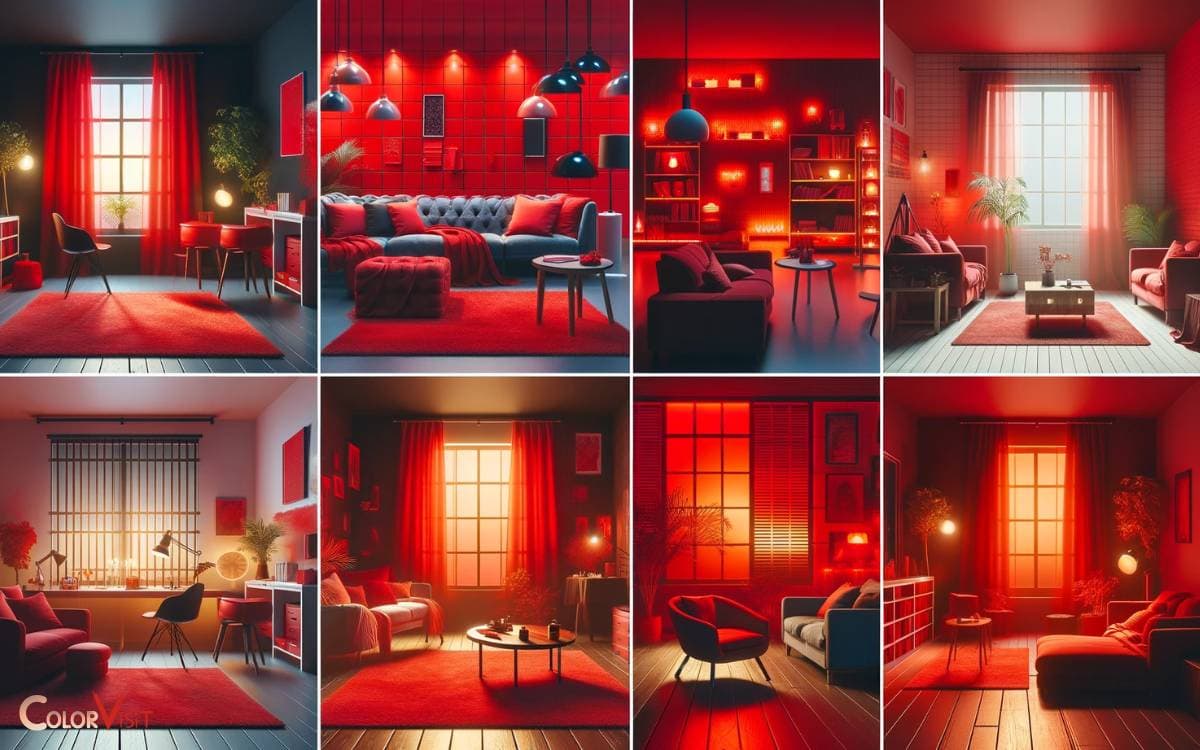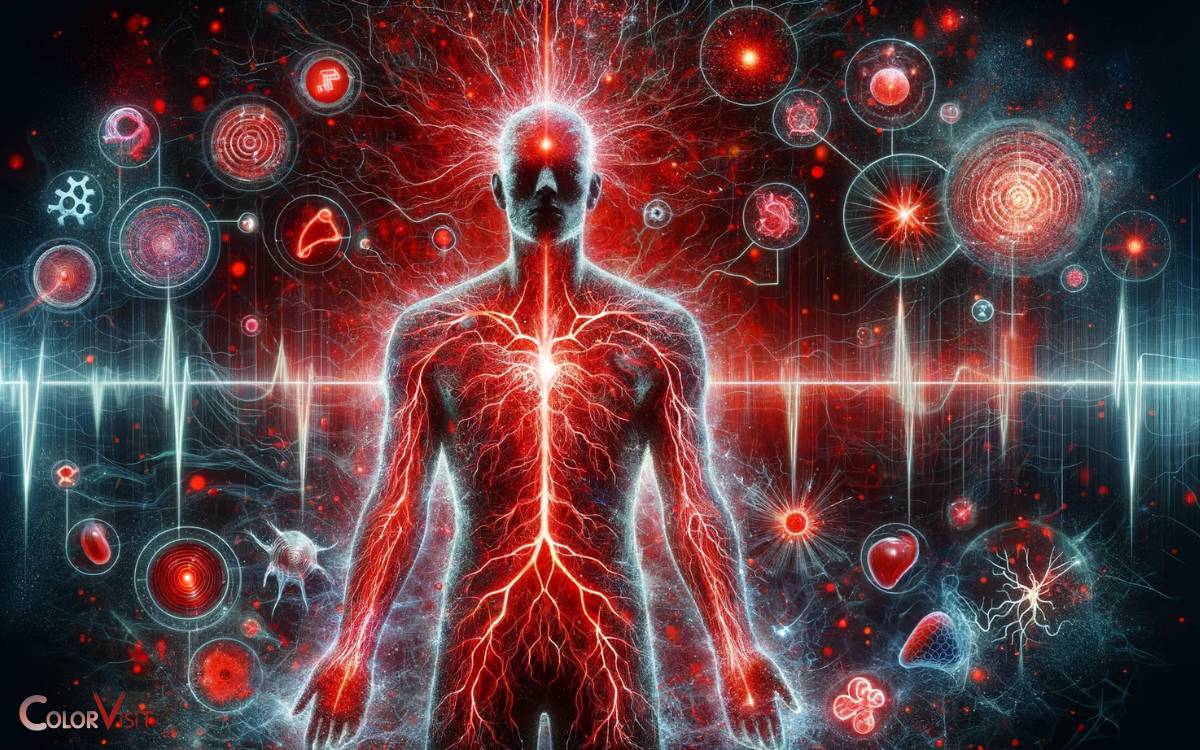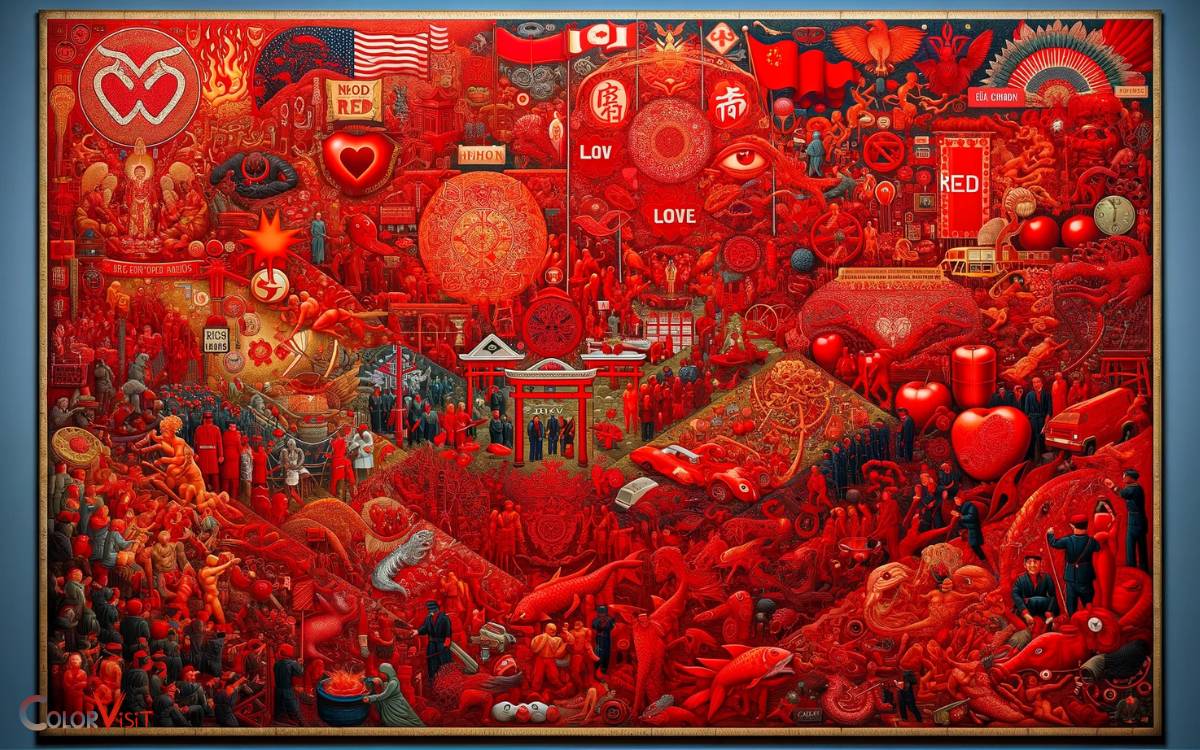Is Red a Calming Color? No!
No, Contrary to popular belief, red is not typically considered a calming color. It is often associated with feelings of excitement, energy, and passion.
While red can draw attention and provoke strong emotions, it is not commonly linked to relaxation or calmness.
The perception of color and its psychological impact can vary among individuals; however, red is generally recognized for its stimulating effects rather than its ability to calm.
For example:
In the realm of color psychology, red’s association with energy and action overshadows any potential calming effects, making it more suitable for dynamic spaces than for areas designed for rest or meditation.
Key Takeaway
The Psychological Impact of Red
Frequently, the psychological impact of the color red is a subject of significant interest and study in various fields, including psychology, marketing, and design. Red is often associated with strong emotions such as passion, excitement, and intensity.
In psychological studies, it has been found that exposure to the color red can evoke physiological responses such as increased heart rate and blood pressure, indicating its ability to stimulate arousal.
Additionally, red has been linked to attention and vigilance, making it a popular choice in marketing and advertising to capture the audience’s focus. In design, the color red is often used to create a sense of urgency or importance.
Understanding the psychological implications of red is crucial for harnessing its powerful effects in various contexts.
Red’s Influence on Mood
Red’s influence on mood is a complex interplay of physiological and psychological factors. Research suggests that red can evoke strong emotions such as passion, excitement, and even aggression.
However, it is important to consider individual differences and cultural influences when examining the impact of red on relaxation and overall mood.
Red and Emotions
Examining the influence of red on mood reveals interesting insights into the emotional impact of this color.
Red has been found to have a significant influence on emotions, with several intriguing findings:
- Excitement: Red is often associated with feelings of excitement and intensity. It has the ability to raise the energy levels and evoke strong emotions.
- Passion: The color red is closely linked to feelings of passion and romance. It can evoke deep emotional responses related to love and desire.
- Aggression: Research suggests that red can also elicit feelings of aggression or dominance. It has been associated with increased heart rate and heightened arousal.
- Attention: Red has a powerful impact on attention and can increase alertness. It is often used to draw focus and create a sense of urgency.
Psychological Impact of Red
The psychological impact of red on mood is a subject of significant interest and study in the field of color psychology.
Red is often associated with strong emotions such as passion, love, and anger. Its influence on human emotions is complex and multifaceted, with both positive and negative effects.
Here is a table illustrating the psychological impact of red on mood:
| Mood | Psychological Impact of Red |
|---|---|
| Aggression | Increases |
| Excitement | Increases |
| Attention | Increases |
Red in Relaxation
In the realm of mood influence, red has been observed to have varying effects on relaxation and emotional states.
When it comes to relaxation, the influence of red on mood is complex and can be both stimulating and calming.
Here are four key points to consider:
Red has been found to increase arousal and excitement levels, making it less conducive to relaxation in some contexts.
However, in certain individuals, red can evoke feelings of warmth and comfort, contributing to a sense of relaxation.
The impact of red on relaxation appears to be influenced by personal experiences, cultural associations, and individual preferences.
Understanding the specific context and individual perceptions is crucial in determining whether red promotes relaxation or hinders it.
The effects of red on the nervous system further elucidate the intricate relationship between this color and relaxation.
Effects of Red on the Nervous System
Research on the effects of red on the nervous system has revealed intriguing insights into its impact on arousal levels, stress response, and mental alertness.
Understanding how exposure to red influences these aspects of the nervous system can provide valuable information for various fields, including design, psychology, and healthcare.
Red and Arousal Levels
- Increased Heart Rate: Studies have shown that exposure to the color red can lead to a temporary increase in heart rate, indicating heightened arousal levels.
- Enhanced Attention: Red has been found to capture attention effectively, leading to improved focus and alertness.
- Impact on Blood Pressure: Research suggests that the color red may elevate blood pressure, influencing the body’s physiological arousal response.
- Activation of the Sympathetic Nervous System: Red is associated with the activation of the sympathetic nervous system, which is responsible for the body’s fight-or-flight response.
Understanding the impact of red on arousal levels and the nervous system provides valuable insights into the psychological and physiological effects of this color, shedding light on its potential to influence human behavior and cognitive processes.
Red and Stress Response
Frequently, red elicits heightened arousal levels and activates the sympathetic nervous system, impacting the body’s stress response.
Studies have shown that exposure to the color red can lead to increased heart rate and blood pressure, indicating a physiological stress response.
This effect is attributed to the association of red with danger and excitement, triggering the release of stress hormones such as adrenaline.
The activation of the sympathetic nervous system, known as the ‘fight or flight’ response, prepares the body to react to perceived threats.
Consequently, prolonged exposure to red may contribute to chronic stress and its associated health implications.
Understanding the impact of red on the nervous system’s stress response is essential in various contexts, from interior design to visual communication, as it can influence individuals’ well-being and performance in different environments.
Red and Mental Alertness
The impact of red on mental alertness and the nervous system is a topic of significance, given its potential to influence cognitive function and overall performance.
Research suggests that:
Red has been found to increase brain wave activity, leading to heightened alertness and attention to detail.
Exposure to red light has been linked to improved performance on tasks requiring vigilance and rapid reactions.
The color red is thought to stimulate the adrenal glands, leading to an increase in adrenaline production, which can enhance focus and mental acuity.
However, prolonged exposure to red may also lead to increased stress and agitation in some individuals, highlighting the complex and multifaceted nature of its impact on mental alertness.
Understanding the nuanced effects of red on mental alertness is crucial for harnessing its potential benefits while mitigating any potential drawbacks.
Red’s Role in Relaxation
Red is often perceived as a calming color due to its ability to promote relaxation and a sense of tranquility.
While red is typically associated with energy and stimulation, research suggests that it also plays a role in relaxation.
Studies have shown that exposure to the color red can lead to a decrease in heart rate and evoke feelings of peacefulness.
This unexpected relationship between red and relaxation challenges conventional perceptions of the color.
It implies that red, when used mindfully, can create a balanced environment that fosters both alertness and serenity.
Cultural Perceptions of Red
Incorporating red into various cultural contexts can reveal diverse interpretations and associations with the color, shedding light on its multifaceted significance beyond traditional perceptions.
Cultural perceptions of red vary widely and offer insights into the complexity of this color’s symbolism.
- Love and Passion: In Western cultures, red is often associated with love, passion, and romance, as seen in the use of red roses and red hearts on Valentine’s Day.
- Luck and Prosperity: In Chinese culture, red symbolizes good luck and prosperity, often used in traditional weddings and during the Lunar New Year.
- Power and Prestige: In some African cultures, red is worn by tribal leaders and holds connotations of power, leadership, and vitality.
- Spirituality and Ritual: In Hinduism, red is associated with the root chakra and represents physical vitality, energy, and the life force.
Red in Therapeutic Settings
Red plays a significant role in therapeutic settings as it has been shown to evoke feelings of warmth and comfort in individuals undergoing treatment.
The color red has been found to stimulate and increase blood circulation, making it beneficial in certain therapeutic contexts.
In color therapy, red is believed to have physical effects on the body, such as raising blood pressure and increasing pulse rate.
This physiological response can be beneficial in therapeutic settings where physical stimulation is needed, such as in cases of depression or lethargy.
Additionally, red is associated with vitality, courage, and inner strength, which can be particularly helpful for individuals dealing with emotional trauma or mental health issues.
Utilizing red in therapeutic environments can contribute to creating a supportive and energizing atmosphere for patients, potentially enhancing the overall effectiveness of treatment.
Practical Tips for Using Red
When using red in therapeutic environments, consider incorporating it in small accents such as throw pillows or artwork to provide a subtle yet impactful touch of warmth and energy.
To effectively use red in interior design and therapeutic settings, consider the following practical tips:
- Balance: Use red in moderation to avoid overwhelming the space and evoking agitation.
- Harmonize: Pair red with calming colors like soft blues and greens to create a balanced and harmonious environment.
- Purposeful Placement: Strategically place red elements to draw attention to specific areas or to evoke a desired emotion.
- Consider Cultural Significance: Be mindful of the cultural associations of red to ensure that its usage aligns with the intended therapeutic goals.
Conclusion
The color red has a complex psychological impact, influencing mood and the nervous system. It is perceived differently across cultures and can be utilized in therapeutic settings.
When used strategically, red can evoke feelings of relaxation and calmness. However, its effects may vary from person to person.
It is important to consider individual preferences and cultural associations when incorporating red into environments.
Overall, the use of red should be approached with caution and sensitivity to its potential effects. As the saying goes, ‘One man’s meat is another man’s poison.’










